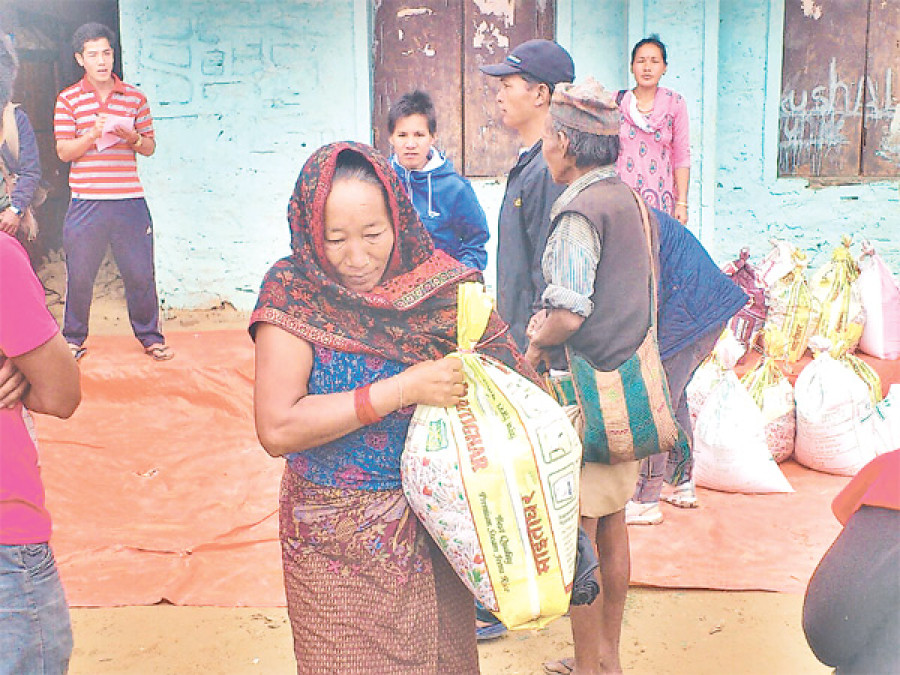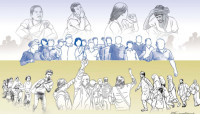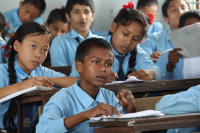Opinion
Let them eat local
Locally-available food like sesame, flax, and amaranth can help provide adequate nutrition to children in the aftermath of the quake
Dr. Aruna Uprety
Noodles and biscuits were distributed as immediate relief in the first few days of the Great Earthquake. Though many public health specialists had strong opinions about such unhealthy food being distributed, given the time and calamity, they did not speak out against this. But after two weeks, if biscuits and junk foods are still being provided to disaster-struck communities, we need to speak out.
Junk comes in packets
In many earthquake-hit areas, I have seen survivors eating only junk food because many private relief efforts distributed only packets of noodles and biscuits. Pregnant mothers and children as young as two were seen eating junk food in earthquake-hit areas. But in some place, it was decided by some health workers, in collaboration with the media, that there would be ‘no more junk food for earthquake survivors’.
Health workers are also worried that many organisations will now come to Nepal with so-called ‘micro-nutrition’ and will ask guardians or parents to feed children those packets, which are expensive, unhealthy, and not sustainable. In Nepal, we have much food that are full of nutrients but are ignored by those who bring in packaged food from the outside and pressure local communities to use them.
When I was working in Sudan, an Ethiopian doctor was working with me and he shared an experience of how Ethiopia has taken up the challenge of reducing malnutrition among children. “We made
flour from dry-sprouted soya beans and chickpeas and used that to make food. Being full of protein, vitamins, calcium and other micronutrients, it helped us combat malnutrition among children. It was cheap and easily available and very easy to disseminate information about,” he said.
I am remembering his words in these difficult days as one of the solutions to combat malnutrition in quake-affected districts. In Nepal, we can also make flour from sprouted beans and distribute this to earthquake-affected areas. This flour will be useful for a longer time period and is much cheaper and more nutritious than packaged food from outside.
Eat what is available
We have many other kinds of food that are ignored by society and policymakers but are healthy with a lot of micronutrients.
Sesame (til) has good fat, calcium, and mineral content and it is one of the healthiest foods. It is used during some festivals but we have not used it yet as a food that can combat malnutrition among children. Along with rice, lentils, and potatoes, sesame seeds and flour can be provided to villages so that children will not suffer from malnutrition in the aftermath of the quake.
In the same way, flax seed (alas or aalsi) can be used to make food full of micronutrients. It contains omega-3 fatty acids and fiber and has antioxidant properties. It can be used as a salad, with lentils, or as vegetables and is easily available and cheap.
Amaranth (latte) can also be used as a vegetable or mixed with wheat or rice flour. It contains iron, magnesium, and high quantity of protein, which most vegetables do not contain. Hundred grams of amaranth contains 9.41 grams of protein and 68.9 grams of carbohydrates as well as 2.15 grams of fiber, which makes it an ideal food. But very few people use it because of a lack of information.
On the fifth day after the earthquake, we went to Botechour in Sindhupalchok and while passing Sankhu, we saw that many farmers, both men and women, were working in the fields and there were many sacks of potatoes to sell. One 80kg sack cost Rs 1,440 and I bought one to distribute to people. Relief organisations and the government should also distribute potatoes to earthquake survivors, instead of noodles.
The Agriculture Ministry has published a booklet on amaranth, potato, and cassava (simal tarul) showing their nutritious value, but sadly, this knowledge has not been applied in practice.
It is time for various international and national organisations to refrain from creating a food dependency, as in Haiti or Sudan. We are capable of growing and feeding our people. But I wonder if our government will be able to communicate this to the INGOs? Still, we should be telling the communities about how they can combat malnutrition with local food so that they understand the value of what is locally available. This may take some time but it will be a sustainable approach.
Dr Uprety writes on nutrition and health




 9.12°C Kathmandu
9.12°C Kathmandu










